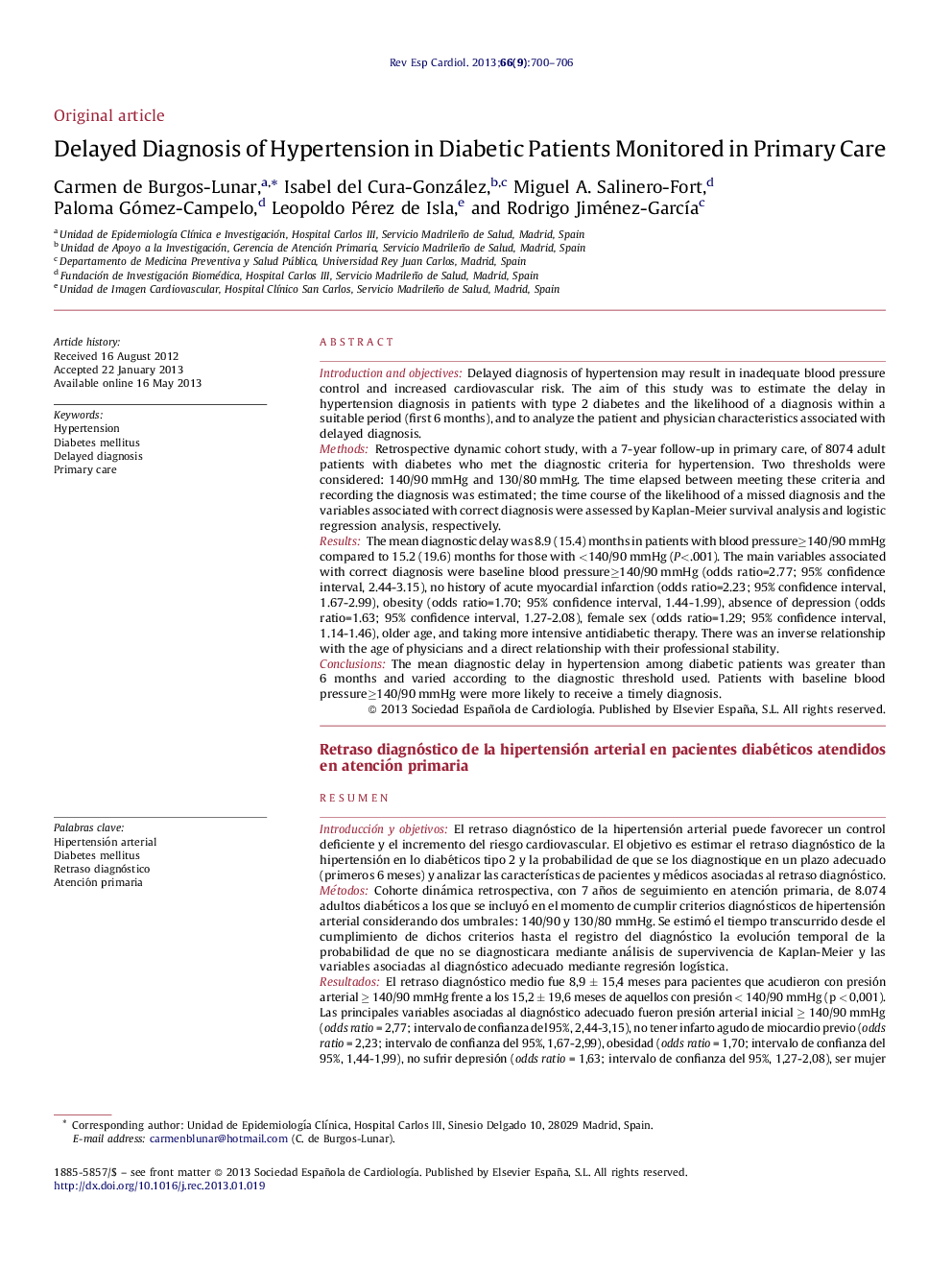| Article ID | Journal | Published Year | Pages | File Type |
|---|---|---|---|---|
| 3017869 | Revista Española de Cardiología (English Edition) | 2013 | 7 Pages |
Introduction and objectivesDelayed diagnosis of hypertension may result in inadequate blood pressure control and increased cardiovascular risk. The aim of this study was to estimate the delay in hypertension diagnosis in patients with type 2 diabetes and the likelihood of a diagnosis within a suitable period (first 6 months), and to analyze the patient and physician characteristics associated with delayed diagnosis.MethodsRetrospective dynamic cohort study, with a 7-year follow-up in primary care, of 8074 adult patients with diabetes who met the diagnostic criteria for hypertension. Two thresholds were considered: 140/90 mmHg and 130/80 mmHg. The time elapsed between meeting these criteria and recording the diagnosis was estimated; the time course of the likelihood of a missed diagnosis and the variables associated with correct diagnosis were assessed by Kaplan-Meier survival analysis and logistic regression analysis, respectively.ResultsThe mean diagnostic delay was 8.9 (15.4) months in patients with blood pressure≥140/90 mmHg compared to 15.2 (19.6) months for those with <140/90 mmHg (P<.001). The main variables associated with correct diagnosis were baseline blood pressure≥140/90 mmHg (odds ratio=2.77; 95% confidence interval, 2.44-3.15), no history of acute myocardial infarction (odds ratio=2.23; 95% confidence interval, 1.67-2.99), obesity (odds ratio=1.70; 95% confidence interval, 1.44-1.99), absence of depression (odds ratio=1.63; 95% confidence interval, 1.27-2.08), female sex (odds ratio=1.29; 95% confidence interval, 1.14-1.46), older age, and taking more intensive antidiabetic therapy. There was an inverse relationship with the age of physicians and a direct relationship with their professional stability.ConclusionsThe mean diagnostic delay in hypertension among diabetic patients was greater than 6 months and varied according to the diagnostic threshold used. Patients with baseline blood pressure≥140/90 mmHg were more likely to receive a timely diagnosis.
ResumenIntroducción y objetivosEl retraso diagnóstico de la hipertensión arterial puede favorecer un control deficiente y el incremento del riesgo cardiovascular. El objetivo es estimar el retraso diagnóstico de la hipertensión en lo diabéticos tipo 2 y la probabilidad de que se los diagnostique en un plazo adecuado (primeros 6 meses) y analizar las características de pacientes y médicos asociadas al retraso diagnóstico.MétodosCohorte dinámica retrospectiva, con 7 años de seguimiento en atención primaria, de 8.074 adultos diabéticos a los que se incluyó en el momento de cumplir criterios diagnósticos de hipertensión arterial considerando dos umbrales: 140/90 y 130/80 mmHg. Se estimó el tiempo transcurrido desde el cumplimiento de dichos criterios hasta el registro del diagnóstico la evolución temporal de la probabilidad de que no se diagnosticara mediante análisis de supervivencia de Kaplan-Meier y las variables asociadas al diagnóstico adecuado mediante regresión logística.ResultadosEl retraso diagnóstico medio fue 8,9 ± 15,4 meses para pacientes que acudieron con presión arterial ≥ 140/90 mmHg frente a los 15,2 ± 19,6 meses de aquellos con presión < 140/90 mmHg (p < 0,001). Las principales variables asociadas al diagnóstico adecuado fueron presión arterial inicial ≥ 140/90 mmHg (odds ratio = 2,77; intervalo de confianza del 95%, 2,44-3,15), no tener infarto agudo de miocardio previo (odds ratio = 2,23; intervalo de confianza del 95%, 1,67-2,99), obesidad (odds ratio = 1,70; intervalo de confianza del 95%, 1,44-1,99), no sufrir depresión (odds ratio = 1,63; intervalo de confianza del 95%, 1,27-2,08), ser mujer (odds ratio = 1,29; intervalo de confianza del 95%, 1,14-1,46), tener más edad o tratamiento antidiabético más intensivo. La edad del médico mostró relación inversa y su estabilidad laboral, relación directa.ConclusionesEl retraso diagnóstico medio de la hipertensión en diabéticos fue > 6 meses y varió según el umbral diagnóstico utilizado. Los pacientes con presión arterial inicial ≥ 140/90 mmHg presentaron mayor probabilidad de diagnóstico adecuado.
